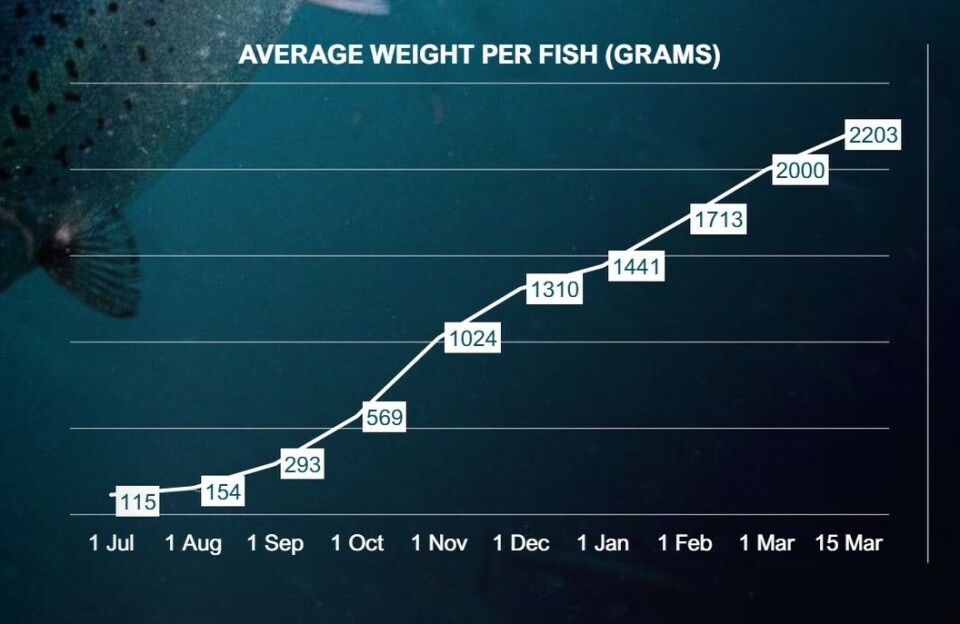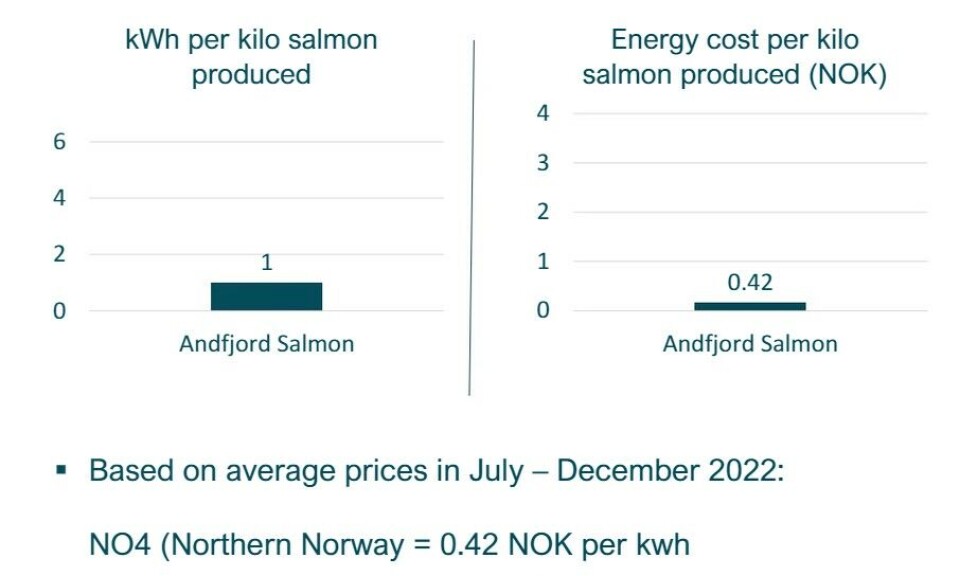
Andfjord Salmon reports continued strong growth and high survival
Company also sees impressive feed conversion ratio and low energy use
Andfjord Salmon, which operates a flow-through land-based salmon farm in Norway, has reported continued strong growth and a high survival rate for its first production cycle.
In a market report, the company said that as of March 15 2023, smolts stocked at 115 grams in July last year had reached an average weight of 2,203 grams.
During the fourth quarter of 2022, the salmon’s average weight grew from 569 grams on 1 October to 1,441 grams at the end of the year.
“Andfjord Salmon achieved solid growth during the second half of 2022 with an accumulated feed conversion ratio (FCR) of 0.94, meaning that each fish requires on average 0.94 kilograms of feed to grow 1 kilogram,” the company said in its Q4 report.

Andfjord points out that the average industry FCR was 1.27 in 2021.
“We are very pleased with the growth rate during the dark season, when the water is also colder,” said chief executive Martin Rasmussen. “At year end, the growth was approximately 40% ahead of our original estimate, which was based on expected seawater temperature and Skretting’s growth table for salmon. I am also pleased that our feed conversion ratio remains good.”
98.1% survival
The survival rate of Andford’s fish is still high and as of 15 March 2023 it was 98.1%.
During the second half of 2022, Andfjord Salmon lost an average of 0.25% of its fish per month due to mortality. The mortality rate was slightly higher in October.
"We had an incident where a light on an ROV (remotely operated vehicle) was not switched off as it should have been," said Rasmussen at a presentation of the results. "This stressed the fish and a few hundred fish died. But it is worth noting that this amounts to approximately 20% of the total mortality in the pool."
So far in 2023, mortality has been reduced to 0.1% per month.
Inflatable cushions
Rasmussen added that Andfjord had also seen fish jumping into the edge of the pool.
"We have remedied that by installing inflatable cushions that give the fish protection when they jump into the pool walls," he said.
After the end of the year, a welfare documentation report, written by Norwegian research organisation Nofima, concluded that “overall, the welfare of fish in the system in the first six months of the documentation project has been good in relation to e.g. The Laksvell (Well Salmon) scoring scheme for input- and result-based indicators for salmon”.
Nofima looked at many operational welfare indicators (OWIs) for the salmon, including water quality and the salmon’s physical environment, fish behaviour, and a revision of further fish health parameters is currently under way.
A more stable temperature
On conditions in Andfjord’s laminar flow pool, Nofima noted: “Water temperature is somewhat more stable than what would be expected at corresponding depths in open cages.”
It added: “Water current speeds, whilst low, have not manifested in poor water quality and seems to be increased by fish presence in system.”
On fish welfare, Nofima said: “The low natural water temperatures the fish have been subjected to over the autumn/early winter have currently not manifested in any welfare or performance risks, or risks for e.g., winter ulcers.”
It also said that the injury status of the fish “has generally been good with the majority of injury based OWIs being scored as absent or mild”.
Researchers said growth “has been higher throughout the
period than that indicated for fish in this weight and temperature range (4 to
14°C) by reference growth tables. It is also in the upper range of values
reported in several previous studies, overall”.
Valuable research
“Receiving this independent third-party verification from a recognised research institute is very valuable for Andfjord Salmon,” said Rasmussen. “We have always been confident in the many advantages of our flow-through system. This report confirms that we were right to be positive about the development of our fish.”
Andfjord Salmon reiterates its goal of carrying out the first slaughter in mid-2023.
The company has the capacity to produce 1,000 gutted weight tonnes of salmon annually in the single flow-through pool it currently operates at Kvalnes on the island on Andøya, but intends to excavate more pools to increase capacity to 19,000 gwt. It said it is currently in the final phase of contract discussions with suppliers about the plan for development.
Andfjord Salmon will invite shareholders to a capital market update during the spring to present the development plan and timeline for phase 2.
90,000 tonnes
It has long-term plans to build farms at two other locations on Andøya, and to build a second facility at Kvalnes, which would take annual production to 90,000 gwt.

Andfjord Salmon uses a patented method of drawing sea water from depth into a pool set below sea level, which the company says substantially reduces energy required for pumping. Energy use is said to be just 1 kWh per kilo of salmon produced, and energy cost, based on relatively cheap northern Norwegian prices, is NOK 0.42 per kilo.
The company is in the middle of its first production cycle, which means it is not yet generating income. The company’s first operating income will be generated in 2023 after the first harvest.
Andfjord Salmon had an operating loss of NOK 22 million(£1.7 m) in the fourth quarter of 2022, compared to a loss of NOK 10.1 m in the same quarter of 2021. The difference is mainly related to higher operating costs as the company and the first pool are now in full operation, which was not case in Q4 2021.
At the turn of the year, Andfjord Salmon had cash and deposits of NOK 82.9 m. This figure does not include unused credit facilities of NOK 25 m. Liquidity is at a comfortable level for the current operating phase.






















































